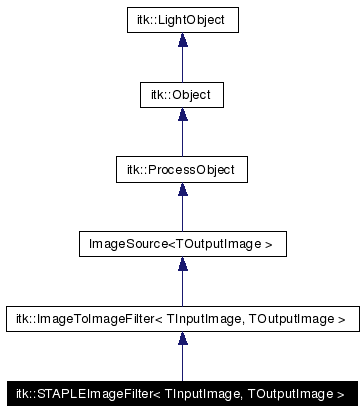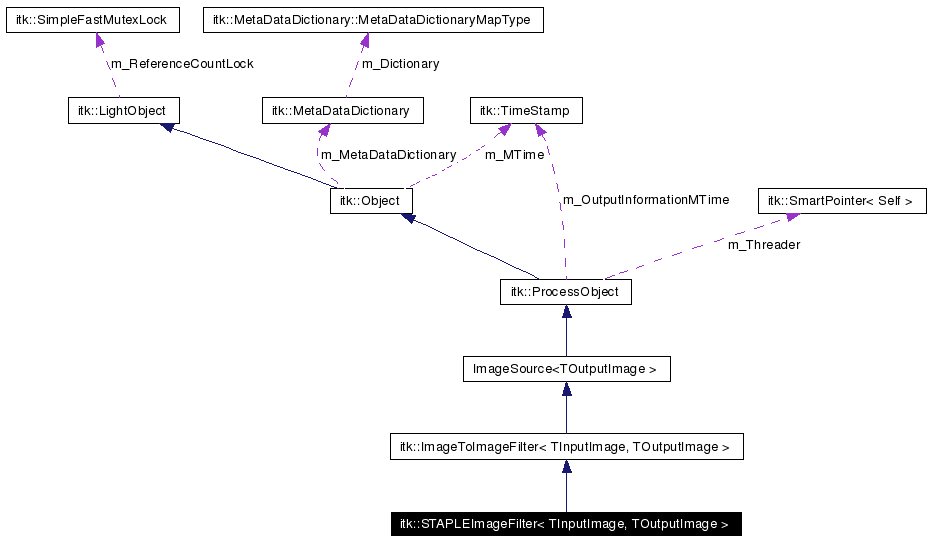
#include <itkSTAPLEImageFilter.h>
Inheritance diagram for itk::STAPLEImageFilter< TInputImage, TOutputImage >:


Public Types | |
| typedef STAPLEImageFilter | Self |
| typedef ImageToImageFilter< TInputImage, TOutputImage > | Superclass |
| typedef SmartPointer< Self > | Pointer |
| typedef SmartPointer< const Self > | ConstPointer |
| typedef TOutputImage::PixelType | OutputPixelType |
| typedef TInputImage::PixelType | InputPixelType |
| typedef NumericTraits< InputPixelType >::RealType | RealType |
| typedef TInputImage | InputImageType |
| typedef TOutputImage | OutputImageType |
| typedef InputImageType::Pointer | InputImagePointer |
| typedef OutputImageType::Pointer | OutputImagePointer |
| typedef Superclass::OutputImageRegionType | OutputImageRegionType |
Public Member Functions | |
| virtual const char * | GetNameOfClass () const |
| itkStaticConstMacro (ImageDimension, unsigned int, TOutputImage::ImageDimension) | |
| const std::vector< double > & | GetSpecificity () const |
| const std::vector< double > & | GetSensitivity () const |
| virtual unsigned int | GetElapsedIterations () |
| virtual void | SetForegroundValue (InputPixelType _arg) |
| virtual InputPixelType | GetForegroundValue () |
| double | GetSensitivity (unsigned int i) |
| double | GetSpecificity (unsigned int i) |
| virtual void | SetMaximumIterations (unsigned int _arg) |
| virtual unsigned int | GetMaximumIterations () |
| virtual void | SetConfidenceWeight (double _arg) |
| virtual double | GetConfidenceWeight () |
Static Public Member Functions | |
| Pointer | New () |
Protected Member Functions | |
| STAPLEImageFilter () | |
| virtual | ~STAPLEImageFilter () |
| void | GenerateData () |
| void | PrintSelf (std::ostream &, Indent) const |
The STAPLE algorithm treats segmentation as a pixelwise classification, which leads to an averaging scheme that accounts for systematic biases in the behavior of experts in order to generate a fuzzy ground truth volume and simultaneous accuracy assessment of each expert. The ground truth volumes produced by this filter are floating point volumes of values between zero and one that indicate probability of each pixel being in the object targeted by the segmentation.
The STAPLE algorithm is described in
S. Warfield, K. Zou, W. Wells, "Validation of image segmentation and expert quality with an expectation-maximization algorithm" in MICCAI 2002: Fifth International Conference on Medical Image Computing and Computer-Assisted Intervention, Springer-Verlag, Heidelberg, Germany, 2002, pp. 298-306
You must provide a foreground value using SetForegroundValue that the STAPLE algorithm will use to identify positively classified pixels in the the input images. All other values in the image will be treated as background values. For example, if your input segmentations consist of 1's everywhere inside the segmented region, then use SetForegroundValue(1).
The STAPLE algorithm is an iterative E-M algorithm and will converge on a solution after some number of iterations that cannot be known a priori. After updating the filter, the total elapsed iterations taken to converge on the solution can be queried through GetElapsedIterations(). You may also specify a MaximumNumberOfIterations, after which the algorithm will stop iterating regardless of whether or not it has converged. This implementation of the STAPLE algorithm will find the solution to within seven digits of precision unless it is stopped early.
Once updated, the Sensitivity (true positive fraction, q) and Specificity (true negative fraction, q) for each expert input volume can be queried using GetSensitivity(i) and GetSpecificity(i), where i is the i-th input volume.
Definition at line 119 of file itkSTAPLEImageFilter.h.
|
|||||
|
Reimplemented from itk::ImageToImageFilter< TInputImage, TOutputImage >. Definition at line 127 of file itkSTAPLEImageFilter.h. |
|
|||||
|
Reimplemented from itk::ImageToImageFilter< TInputImage, TOutputImage >. Definition at line 149 of file itkSTAPLEImageFilter.h. |
|
|||||
|
Image typedef support Reimplemented from itk::ImageToImageFilter< TInputImage, TOutputImage >. Definition at line 147 of file itkSTAPLEImageFilter.h. |
|
|||||
|
Definition at line 138 of file itkSTAPLEImageFilter.h. Referenced by itk::STAPLEImageFilter< TInputImage, TOutputImage >::~STAPLEImageFilter(). |
|
|||||
|
Reimplemented from itk::ImageSource< TOutputImage >. Definition at line 150 of file itkSTAPLEImageFilter.h. |
|
|||||
|
Superclass typedefs. Reimplemented from itk::ImageToImageFilter< TInputImage, TOutputImage >. Definition at line 153 of file itkSTAPLEImageFilter.h. |
|
|||||
|
Some convenient typedefs. Reimplemented from itk::ImageSource< TOutputImage >. Definition at line 148 of file itkSTAPLEImageFilter.h. |
|
|||||
|
Extract some information from the image types. Dimensionality of the two images is assumed to be the same. Definition at line 137 of file itkSTAPLEImageFilter.h. |
|
|||||
|
Reimplemented from itk::ImageToImageFilter< TInputImage, TOutputImage >. Definition at line 126 of file itkSTAPLEImageFilter.h. |
|
|||||
|
Definition at line 139 of file itkSTAPLEImageFilter.h. |
|
|||||
|
Standard class typedefs. Reimplemented from itk::ImageToImageFilter< TInputImage, TOutputImage >. Definition at line 124 of file itkSTAPLEImageFilter.h. Referenced by itk::STAPLEImageFilter< TInputImage, TOutputImage >::~STAPLEImageFilter(). |
|
|||||
|
Reimplemented from itk::ImageToImageFilter< TInputImage, TOutputImage >. Definition at line 125 of file itkSTAPLEImageFilter.h. |
|
|||||||||
|
Definition at line 222 of file itkSTAPLEImageFilter.h. |
|
|||||||||
|
Definition at line 229 of file itkSTAPLEImageFilter.h. References itk::STAPLEImageFilter< TInputImage, TOutputImage >::InputPixelType, and itk::STAPLEImageFilter< TInputImage, TOutputImage >::Self. |
|
|||||||||
|
A version of GenerateData() specific for image processing filters. This implementation will split the processing across multiple threads. The buffer is allocated by this method. Then the BeforeThreadedGenerateData() method is called (if provided). Then, a series of threads are spawned each calling ThreadedGenerateData(). After all the threads have completed processing, the AfterThreadedGenerateData() method is called (if provided). If an image processing filter cannot be threaded, the filter should provide an implementation of GenerateData(). That implementation is responsible for allocating the output buffer. If a filter an be threaded, it should NOT provide a GenerateData() method but should provide a ThreadedGenerateData() instead.
Reimplemented from itk::ImageSource< TOutputImage >. |
|
|||||||||
|
Scales the estimated prior probability that a pixel will be inside the targeted object of segmentation. The default prior probability g_t is calculated automatically as the average fraction of positively classified pixels to the total size of the volume (across all input volumes). ConfidenceWeight will scale this default value as g_t = g_t * ConfidenceWeight. In general, ConfidenceWeight should be left to the default of 1.0. |
|
|||||||||
|
Get the number of elapsed iterations of the iterative E-M algorithm. |
|
|||||||||
|
Set get the binary ON value of the input image. |
|
|||||||||
|
Set/Get the maximum number of iterations after which the STAPLE algorithm will be considered to have converged. In general this SHOULD NOT be set and the algorithm should be allowed to converge on its own. |
|
|||||||||
|
Run-time type information (and related methods) Reimplemented from itk::ImageToImageFilter< TInputImage, TOutputImage >. |
|
||||||||||
|
After the filter is updated, this method returns the Sensitivity (true positive fraction, p) value for the i-th expert input volume. Definition at line 178 of file itkSTAPLEImageFilter.h. References itkExceptionMacro. |
|
|||||||||
|
After the filter is updated, this method returns a std::vector<double> of all Sensitivity (true positive fraction, p) values for the expert input volumes. Definition at line 171 of file itkSTAPLEImageFilter.h. |
|
||||||||||
|
After the filter is updated, this method returns the Specificity (true negative fraction, q) value for the i-th expert input volume. Definition at line 190 of file itkSTAPLEImageFilter.h. References itkExceptionMacro. |
|
|||||||||
|
After the filter is updated, this method returns a std::vector<double> of all Specificity (true negative fraction, q) values for the expert input volumes. Definition at line 163 of file itkSTAPLEImageFilter.h. |
|
||||||||||||||||||||
|
Extract some information from the image types. Dimensionality of the two images is assumed to be the same. |
|
|||||||||
|
Method for creation through the object factory. Reimplemented from itk::Object. |
|
||||||||||||||||
|
Methods invoked by Print() to print information about the object including superclasses. Typically not called by the user (use Print() instead) but used in the hierarchical print process to combine the output of several classes. Reimplemented from itk::ImageToImageFilter< TInputImage, TOutputImage >. |
|
||||||||||
|
Scales the estimated prior probability that a pixel will be inside the targeted object of segmentation. The default prior probability g_t is calculated automatically as the average fraction of positively classified pixels to the total size of the volume (across all input volumes). ConfidenceWeight will scale this default value as g_t = g_t * ConfidenceWeight. In general, ConfidenceWeight should be left to the default of 1.0. |
|
||||||||||
|
Set get the binary ON value of the input image. |
|
||||||||||
|
Set/Get the maximum number of iterations after which the STAPLE algorithm will be considered to have converged. In general this SHOULD NOT be set and the algorithm should be allowed to converge on its own. |
 1.3.5 written by Dimitri van Heesch,
© 1997-2000
1.3.5 written by Dimitri van Heesch,
© 1997-2000